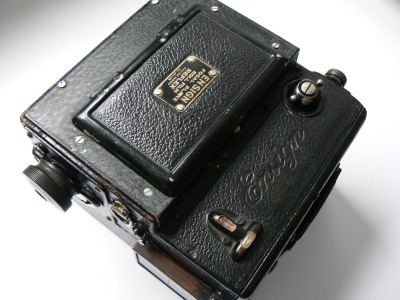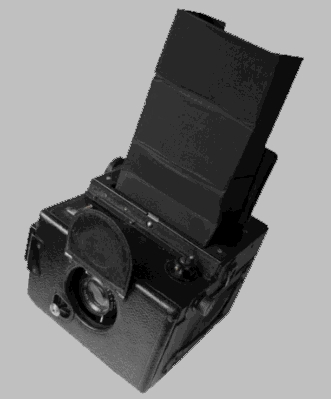
The Ensign Roll Film Reflex

Some 80
years after it's production, I purchased this Ensign Reflex on a fair in Houten
Holland. At the first glance, it was worth the price I paid for it. But a closer
look showed some major problems.
To achieve my goal to take pictures with the oldie some day, I'd have to
solve the problems by repairing.
There is a missing viewing hood and there are shutter and mirror setting
problems.
The
Ensign Roll Film Reflex 1920's
Camera #E9680
In General
In the 1920's, the Houghton Butcher Ltd. produced the interesting designed,
Ensign roll film reflex camera with focal plane shutter. The camera, if closed,
without open viewing-hood, looks like a compact box camera. Even the lens is
covered with a lens-hood. The camera, for it's time, was compact. A closer
look learns that we have to do with a professional press camera. The advantages
of this particular camera for professional use in that time, where:
1) Reflex. What you see is what you get. Reverse left to right !
2) Focal plane shutter. Fast shutter-times up to 1/500 sec.
2) Quick film advancing. 6x9 cm on 120 Roll Film.
3) Security. No heavy breakable glass-plates.
4) Extra Newton (sport) finder.
5) Compact, solid, reliable housing.
The Outside.
The reflex works by a mirror looking
through the Aldis-Butcher Anastigmat f 4,5, into the world outside and projects
its image on the ground-glass on top of the camera. The viewing hood permits a
good view at the ground glass, which can be dark or light, depending on
the diaphragm setting from 4,5 to 32.
It must be said, that the position of the diaphragm setting on the lens is not
very handy.
Because the film advancing
handle is small sized and the position of the handle on the left side of the top
of the box is not ideal for right handed photographers, it's a big advantage
compared to the, in that period of time usual, heavy and breakable glass-plates.
Glass-plates and sheet film holders handling is quite complicating and demands a
lot of skill as one should not forget to open the dark-slide before
exposing and to slide it back again after exposing. On the other hand, the
roll-film was not generally used, as newspaper darkrooms prefered to develop
each shot separately to give optimum quality negatives for half tone block
making.
As advancing the film and cocking the shutter, are not synchronized, it's
obvious that even this reflex roll-film camera is not a guarantee against blanks
or double exposures.
On the right front-side of the camera a finder is located and on the opposite
side, covered by a black metal box, an eye piece. It's called a Newton finder.
Though it's not equipped with a coupled range finder, it permits the user rapid
focusing during events in the streets and on the sporting grounds, where there
is no time to use the viewing hood.
A look inside.
To open the camera, push the lock on the bottom of the camera. The hinged door
opens and shows the inner side of the Ensign Reflex. The 6x9 cm roll film
allowed the designer to make a compact housing, as the spools of the film find a
place, left and right, next to the built-in lens, in front of the camera. In
this front, a build-in mechanism, controlled by the knob on the left side of the
camera, moves the lens, located in a lens-box, to adjust the distance to
the object. To prohibit light coming into the mirror house, the lens is placed
in a kind of bellow. On the right side of the lens-box, the unexposed spool
finds its place. The film runs around the mirror-box to the winding spool on the
left side of the lens-box. On the back of the mirror-box, you can find the 6x9
cm focal plane shutter opening. The bottom of the mirror-case can easily be
opened by sliding the bottom-plate off. It allows one to check the movements of
the lower blinds or to check or adjust minor mirror problems. Until so far the
legitimate access to the inner of the camera.
Discovery.
But there is more to discover and therefore we tackle the viewing-hood-case by
unscrewing the 6 screws on top of it, but leave the two on the right and the two
on the left from the hinged door untouched. The view-hood-case comes off easily
and now it's obvious why we did not unscrew the four screws on top. The leather
viewing hood is attached to the case and if it is not necessary to repair it, we
leave it as it is. After removing the view-hood-case, we see the ground glass
hold by two stripes of metal. Four more screws further and we're looking on, or
maybe into the mirror. No need to say: "Do not touch the surface of the
mirror", but if necessary, clean the dirty mirror, very careful, with
a soft paint brush. On the rear you can study the movements of the upper blind,
by turning the shutter-cocking-knob. Don't unscrew the cocking-knob without
making a mark of it's position. This is essential for the correct
shutter-time.

It took a while, but
finally I had some spare time to reconstruct the missing viewing hood.
How to
build a viewing hood.
Design and pre-production process results in paper model ready to be used for a try out into your camera.
to be continued...